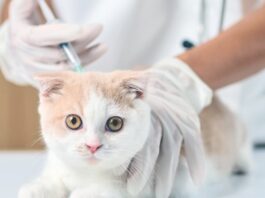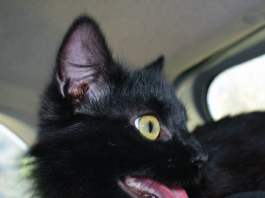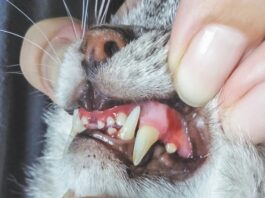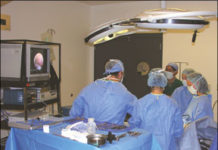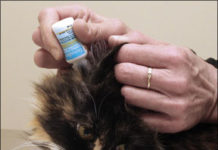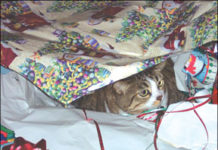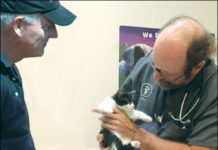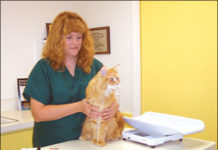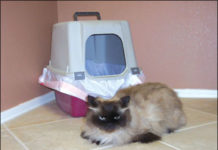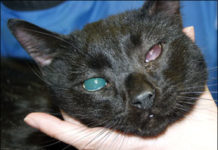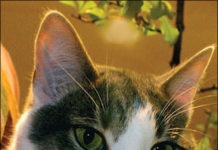Laparascopic Surgery
Your normally active cat isnt eating well, and shes suffering from intermittent vomiting and diarrhea. You make an appointment at the veterinary clinic and during the exam, your veterinarian recommends a liver biopsy to determine exactly whats going on. Sounds simple enough, but taking a biopsy requires that your cat be placed under general anesthesia and her abdomen cut open so the veterinarian can take a small sample of the liver. Afterward, the wound is sutured and your cat must remain in the hospital for a day or two for observation, all the while receiving medication to alleviate her post-operative pain. In the past, this was the typical scenario for all exploratory surgeries in the abdominal region of a cats body. Today, with advances in veterinary medicine, veterinarians have access to a revolutionary surgical technique called laparoscopy - a minimally invasive medical procedure that is being used with increasing frequency for a variety of diagnostic and surgical purposes. The technology is a giant step forward for the veterinary surgical field, according to James Flanders, DVM, an associate professor of surgery at Cornell Universitys College of Veterinary Medicine. "Traditionally, veterinarians would perform an open surgery, where we make a large, mid-line incision in the abdomen in order to look inside and do whatever we need to do, whether its to take a biopsy of the liver or to remove bladder stones. Now, with the laparoscope, we only need to a few small incisions (each one about a half-inch in length). Because the incisions are so tiny, the animal experiences far less post-operative pain and recovers faster."
Feline Ear Disorders
Among a normal, healthy, and properly cared-for cats many distinctive attributes is its astoundingly acute sense of hearing. While the human auditory system is capable of detecting sounds ranging in frequency up to about 20,000 vibrations per second, cats typically can sense sounds pulsating at 60,000 vibrations per second or greater. This impressive acoustic sensitivity has been honed over the ages to serve a cat in countless ways - signaling the stealthy approach of a dangerous predator, for example, or detecting the underground movement of a burrowing rodent. Although most cats will go through life without experiencing a serious problem with their ears, owners should know that a variety of conditions - including congenital defects, infections, trauma and age-related changes - can be extremely painful and may compromise an animals hearing. Most feline ear disorders are readily treatable and will not result in permanent hearing loss, notes James Flanders, DVM, an associate professor of surgery at Cornell Universitys College of Veterinary Medicine. However, some conditions may render a cat partially or totally deaf, especially if they remain unrecognized and untreated.
The Danger of String
Brooke Remy of Boston, MA, was delighted to watch her cat Puddles play with a long, pink ribbon she had just taken off a gift box. He twirled around and around and rolled over on the floor. Brooke tired before Puddles did, and left the room for about five minutes. When she returned, the ribbon was gone - except for about two inches sticking out of Puddless mouth. He was coughing and drooling. Running over to him, Brooke began slowly pulling the ribbon out of his mouth, watching in terror and amazement as she removed eight inches of wet pink ribbon from his throat. Puddles was lucky that Brooke had returned in time. If he had swallowed the ribbon without Brookes quick intervention, he could have suffered very serious, even life-threatening, damage to his intestinal tract.
Is Your Aging Cat Seeking Attention?
These days, despite what we like to consider modern conveniences, people commonly complain that they just cannot find the time to get a good nights sleep. So much to do, so little time. When we finally do settle into bed, we like to be left to our dreams, undisturbed until the alarm takes us to tomorrow. Noisy neighbors, construction crews and barking dogs are beyond our control. But, what an unexpected, and unpleasant, surprise to be awakened by ones own cat! Restless behavior may be particularly hard to understand when your cat has spent the first 12 years of his life refusing to leave the covers until a decent sunbeam appears. The first time that a senior cats cries call a person from sleep, there may be a sympathetic response. A naturally concerned owner might check the food supply. The next occurrence will be more puzzling. Clearly the cat is not wanting for food. Could there be another cat in the yard? Maybe a critter got into the house?
Short Takes: 11/08
A recent report in the Journal of the American Veterinary Medical Association provided encouraging reassurance that lessons were learned from the tragic melamine contamination of pet food in 2007. Several of the investigators in the study "Clinicopathologic, histologic, and toxicologic findings in 70 cats inadvertently exposed to pet food contaminated with melamine and cyanuric acid" (JAVMA Vol. 233, No. 5) were from Cornell, where the New York State Animal Health Diagnostic Center did some of the groundwork that led to the largest recall of cat and dog food in U.S. history. The 70 cats in this study were not privately owned, nor were they laboratory cats that were deliberately fed suspect food to see if theyd get sick. Rather, they were 70 animals (from a licensed commercial cattery) that happened to be engaged in scientific diet-preference studies when the melamine contamination problem hit the national news. It was their good luck, however, to be where expert veterinary medical care was immediately at hand.
Feline Vision Problems: A Host of Possible Causes
Owing to several unique features developed over centuries in the wild, the modern cat typically possesses powerful visual acuity that enables it to function effectively both indoors and beyond the confines of its home. Unfortunately, the feline ocular apparatus is vulnerable to injuries and a wide variety of diseases that can dramatically impair a cats eyesight or, worst case, render it partially or totally blind. "We see cats that are either blind or going blind several times a week," says Thomas Kern, DVM, associate professor of ophthalmology at Cornell Universitys College of Veterinary Medicine. "Most of these animals have eye disease as a primary disorder - they have no other health problems. And most of them are middle-aged or elderly cats whose vision loss has been progressing for years." As is true for virtually all threats to feline health, the earlier a cats vision problem is diagnosed, the more effectively it can be treated - unless, of course, the animals blindness has progressed irreversibly by the time it is noticed. Therefore, Dr. Kern urges owners to keep an eye out for any behavioral or physical indications that a cat is having a vision problem and to report any such signs to a veterinarian without delay.
Finding Emergency Care
Perhaps the most important characteristic of a responsible cat owner is the ability to distinguish the signs of minor feline illnesses from those calling for an immediate trip to the nearest animal emergency care facility. Cat owners should be equipped ahead of time to deal promptly with such a crisis. They should know precisely where the clinic is located, the speediest route to get there, how to transport the afflicted animal, what documents they should take to the facility - and what to expect to happen upon arrival. Feline emergency cases are by no means rare, says Gretchen Schoeffler, DVM, chief of emergency and critical care services at the Cornell University Hospital for Animals (CUHA). She and her colleagues typically treat as many as 10 or 15 severely ill cats each week in the hospitals emergency unit, which, like most such facilities in the U.S., is open 24 hours a day, seven days a week.
Help Calm Anxiety at the Vet’s Office
Isnt it remarkable that most cats are well-behaved when they visit their veterinarians? First, they are captured and put into an automobile. They remain in their containers, sheltered but helpless, in a room filled with the scent of unfamiliar cats, humans and even dogs. Finally, every bit of security is lost when the cat is removed from its newfound shelter and the veterinary team places the cat on the examination table. Why do cats behave so nicely? Fear can sometimes render a cat motionless and therefore cooperative. Fearful cats - whether immobile or aggressive - can benefit from a behavior modification specifically designed to address high arousal. But what about the average cat, dare I say the "normal" cat? There may be no indication for intensive therapy or anxiety-reducing medication. But clearly, the veterinary experience is not entirely stress-free. Rather than take a cats good behavior for granted, why not reduce some of the stressors that can occur during a visit to the veterinary hospital? Lets examine some components of the visit that could trigger anxiety.
Caring for the Constipated Cat
Your cat has always been a creature of habit when it comes to moving his bowels. Twice a day - once in the morning and once in the evening - he shuffles to his litter box and gracefully relieves himself. If Plato should ever break that pattern and not move his bowels for a day or two, youd be wise to have him examined by your veterinarian right away. Its possible that he is constipated, a condition that will probably be easily relieved if spotted early. Without diagnosis and proper treatment, however, his constipation could progress rapidly to a serious threat to his health, perhaps his life.
Danger in the Garden
Nothing gives you more pleasure on a warm and sunny afternoon than to sit peacefully beside your garden and thrill at the sight of the blossoming lilies, chrysanthemums and foxglove. You especially like the graceful yew shrubs bordering this little patch of earth - a touch you added only recently. And the philodendron thats finally coming into its own, way back there near the fence, is beautiful beyond words. Your cat sits quietly in your lap, apparently enjoying the view as much as you are. But heaven forbid that she would decide to investigate the garden at close range and show her horticultural appreciation by nibbling at one of the plants. Tulips, lilies, foxglove, yew shrubs and philodendron are among hundreds of plants that are known to be poisonous to cats. Ingesting just a small leaf of some common ornamental plants could make your little companion quite ill. And without appropriate first aid and prompt veterinary treatment, swallowing a sizable amount could be fatal to her.
Diagnosis: Cataracts
Cats eyes, like those of humans and many other animals, are complex arrangements of delicate structural components that operate harmoniously in a normal, healthy animal to enable keen vision. Unfortunately, things sometimes go wrong with one or more of these components as a result of disease, aging, traumatic injury or genetically acquired defects. Cataracts can seriously impair a cats vision and even cause blindness. Compared to the frequency of its occurrence in humans and dogs, this ocular disorder is rarely seen in cats, says Thomas Kern, DVM, associate professor of ophthalmology at Cornell Universitys College of Veterinary Medicine. Nevertheless, all cat owners should know the physical and behavioral signs of this disorder and the special needs of a visually impaired feline.
Short Takes: 02/08
Veterinary science is finally taking a serious look at arthritis in cats, as reported in "Evaluation of Client-Specific Outcome Measures and Activity Monitoring to Measure Pain Relief in Cats with Osteoarthritis" (Journal of Veterinary Internal Medicine, Vol. 21, No. 3). Between 25 and 30 percent of older dogs suffer the pain and immobility of osteoarthritis. But veterinary medicine has neither an estimate of the occurrence in cats nor an approved means of pain relief. So researchers at the University of North Carolinas veterinary school asked 13 owners of older cats (between 10 and 19 years) to participate in an experiment. The cats were given complete exams, including X-rays of their legs, hips, paws and spines. To the owners surprise, virtually every cat in the study had several joints where osteoarthritis could be causing pain or restricting movement.



